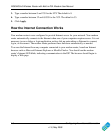
DG834GUv5 Wireless Router with Built-in DSL Modem User Manual
1-6 Configuring Your Internet Connection
v1.0, May 2009
Internet IP Address • Get Dynamically from ISP. Your ISP uses DHCP to assign
your IP address. Your ISP automatically assigns these
addresses.
• Use Static IP Address. Enter the IP address that your ISP
assigned. Also enter the IP subnet mask and the gateway IP
address. The gateway is the ISP’s modem router to which
your modem router will connect.
• Use IP Over ATM (IFoA). Your ISP uses Classical IP
addresses (RFC 1577). Enter the IP address, IP subnet
mask, and gateway IP addresses that your ISP assigned.
Domain Name Server (DNS) Address The DNS server is used to look up site addresses based on
their names.
• Get Automatically from ISP. Your ISP uses DHCP to
assign your DNS servers. Your ISP automatically assigns
this address.
• Use These DNS Servers. If you know that your ISP does
not automatically transmit DNS addresses to the modem
router during login, select this option, and enter the IP
address of your ISP’s primary DNS server. If a secondary
DNS server address is available, enter it also.
NAT (Net Address Translation) NAT automatically assigns private IP addresses (10.1.1.x) to
LAN-connected devices.
• Enable. Usually NAT is enabled.
• Disable. This disables NAT, but leaves the firewall active.
Disable NAT only if you are sure that you do not require it.
When NAT is disabled, only standard routing is performed
by this router. Classical routing lets you directly manage the
IP addresses that the DG834GUv5 uses. Classical routing
should be selected only by experienced users.
a
• Disable Firewall. This disables the firewall in addition to
disabling NAT. With the firewall disabled, the protections
usually provided to your network are disabled.
Table 1-1. Basic Settings Fields Description
Settings Description


















